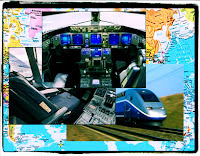If Fish Could Draw… How Limitations of One Media Drive Creativity in Other Media
 If fish could draw perhaps their drawings would all be done with a fisheye perspective, though PJ O’Rourke once famously remarked that if fish really did see like that we could go after them with baseball bats and not need to buy expensive fly rods. Since the stone age artists have drawn and painted with the normal human eye perspective, but I have noticed that nowadays they sometimes draw and paint with a perspective that no human had seen until wide angle lenses were invented.
If fish could draw perhaps their drawings would all be done with a fisheye perspective, though PJ O’Rourke once famously remarked that if fish really did see like that we could go after them with baseball bats and not need to buy expensive fly rods. Since the stone age artists have drawn and painted with the normal human eye perspective, but I have noticed that nowadays they sometimes draw and paint with a perspective that no human had seen until wide angle lenses were invented.I have in front of me a book* by the renowned Swedish illustrator Catarina Kruusval which is mostly drawn in this style. Ms Kruusval is clearly inspired by wide angle lens images because she draws landscapes with an exaggerated earth curvature effect and also drawings from above with distorted verticals. Probably she has seen landscape photos taken with very wide lenses. I suspect she is also influenced by security camera viewpoints which are both wide angle and also generally taken from above. A closer look reveals that the perspective is not actually technically correct but the influence is beyond doubt.
Everyone expects that technology artifacts of one media will influence that media, but what I find more intriguing is the influence that these limitations have on work in unrelated media, as happens in this case. Wide angle lenses have been used in still photography, movies and TV, but they can only be an indirect influence on illustrators.
An outstanding multiple example of this concept is the Broadway musical “City of Angels” written by the late Larry Gelbart. I was lucky enough to catch this show during its short run at the Prince of Wales theater in London in 1993. Many theatrical productions borrow ideas from movies and TV, but rarely on such a scale.
First of all, throughout the show there is an “author” typing a script on one side of the stage. As he types the scene is played beside him, but then when he changes his mind and cancels what he types the actors “rewind” the scene, doing all their moves backwards and also saying their lines backwards. Clearly no playwright could have imagined such a scene until they had seen film reversed in a moviola, or later a VCR or DVD player.
In addition, and less unusually, the musical is written to be played in a way that mimics film and video editing. This is done partly by fast cuts between one scene on one side of the stage and another located on the other side done simply by switching lights on and off. More intriguingly, there are also some transitions that clearly mimic the match dissolve technique. At one point, for example, there is a body lying in the morgue surrounded by other characters. Suddenly the lights change, some players disappear in the shadow and others emerge into the light while the “body” turns over and becomes someone else having a massage.
You see other examples almost daily. In the “Dora the Explorer” TV show, for example, objects are indicated by a “mouse click” effect that is obviously borrowed from personal computers. And it is not just a modern practice. Stephen Jay Gould noted in an essay about scientific illustration that the widespread use of the aquarium in the 1800s changed the way artists drew and painted fish. Before aquariums became popular -- a few wealthy ancient Romans had them, but not poor artists -- fish were usually painted out of water; afterwards they suddenly appeared viewed from their own level.
Examples like this are all around us. You see them in books, you see them in stage shows and you find them in art galleries – and maybe also in some other places that I haven’t thought of looking yet – but I will not share more of them here because I am preparing a new lecture on this topic and I don’t want to spoil the surprise.
* “Fia och djuren pa dagis” by Catarina Krussval, 2007



Comments